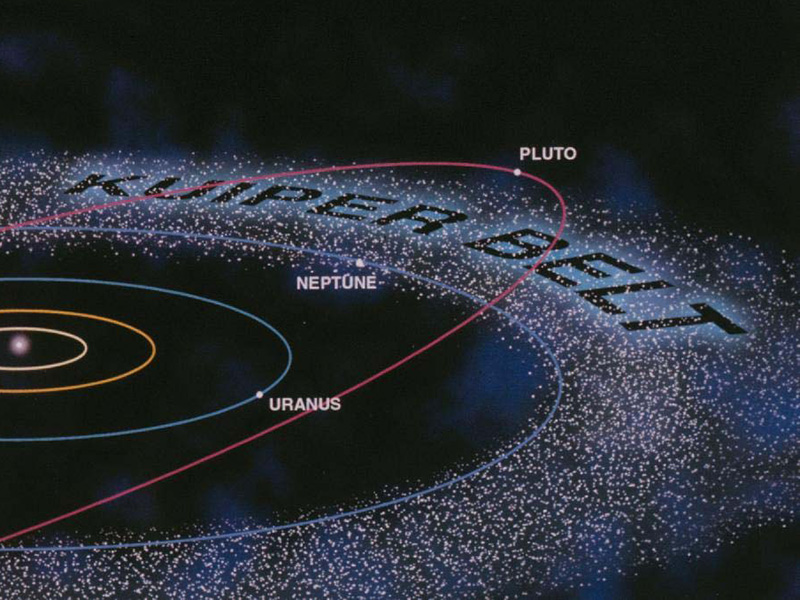- Altjira is a pair of space rocks in the Kuiper Belt. Their gravity keeps them bound together. But is it really just a double?
- The Altjira system might actually be a triplet, a new study of data from the Hubble and Keck telescopes suggests. Three bodies connected together by gravity.
- It would be only the second such system found in the Kuiper Belt so far, if confirmed. But it would also hint at there being many more, not yet identified.
Rare Kuiper Belt triplet might be one of many
Astronomers have found a growing number of binary objects in the distant Kuiper Belt region of the outer solar system, where Pluto orbits. But they had only identified one triple system of such icy space rocks … until now. Researchers using NASA’s Hubble Space Telescope and the ground-based W. M. Keck Observatory in Hawaii said on March 4, 2025, that another binary system in the Kuiper Belt – known as 148780 Altjira – might actually be a triplet instead. If confirmed, it would suggest there are many more triple systems waiting to be discovered.
The researchers published their peer-reviewed findings in The Planetary Science Journal on March 4, 2025.
2025 EarthSky lunar calendar is available now. A unique and beautiful poster-sized calendar with phases of the moon for every night of the year. Get yours today!
Meet Altjira
The Altjira system is 3.7 billion miles (6 billion km) away, in a desolate outer region of the solar system called the Kuiper Belt. This belt contains thousands of icy space rocks called Kuiper Belt Objects (KBOs). The Hubble telescope had already identified two such bodies in the Altjira system. This is a binary system, where the two objects are gravitationally bound to and co-orbit each other. Astronomers determined the two Altjira objects were 4,700 miles (7,600 km) apart.
The Kuiper Belt object 148780 Altjira, already known to be a binary system shows signs of containing a third member in new Hubble observations: bit.ly/3EQtQnK ? ?
— spacetelescope.bsky.social (@spacetelescope.bsky.social) 2025-03-04T16:05:09.090Z
Is the Altjira system a Kuiper Belt triplet?
But now, the newest study using both Hubble and the Keck observatory suggests that there are actually three space rocks in this system, not just two. The combined observations span 17 years. The researchers found the innermost body is likely two objects so close together that telescopes normally see them as just one object. If confirmed, Altjira will be only the second triple system discovered so far in the Kuiper Belt. Lead author Maia Nelsen, a physics and astronomy graduate at Brigham Young University in Provo, Utah, said:
The universe is filled with a range of three-body systems, including the closest stars to Earth, the Alpha Centauri star system, and we’re finding that the Kuiper Belt may be no exception.
Nelsen further explained:
With objects this small and far away, the separation between the two inner members of the system is a fraction of a pixel on Hubble’s camera, so you have to use non-imaging methods to discover that it’s a triple.
Co-author Darin Ragozzine, also at Brigham Young University, said:
Over time, we saw the orientation of the outer object’s orbit change, indicating that the inner object was either very elongated or actually two separate objects.

Most likely explanation
A triple system is the most likely explanation, although there are still a few other possibilities, Nelsen added:
A triple system was the best fit when we put the Hubble data into different modeling scenarios. Other possibilities are that the inner object is a contact binary, where two separate bodies become so close they touch each other, or something that actually is oddly flat, like a pancake.
Arrokoth, which NASA’s New Horizons spacecraft visited in 2019, is a great example of a contact binary.
The realm of Kuiper Belt Objects
The Kuiper Belt is similar to the main asteroid belt between Mars and Jupiter. But it lies in the distant outer solar system, beyond the orbit of Neptune. Astronomers have found more than 3,000 Kuiper Belt Objects so far. The largest one we know of is the dwarf planet Pluto. Researchers estimate there might be hundreds of thousands more space rocks here, larger than 10 miles in size.
The 3-body problem
Three-object systems like Altjira bring to mind the three-body problem, which inspired the recent Netflix sci-fi series the 3 Body Problem (an adaptation of Liu Cixin’s famous novel series). The three-body problem relates to how scientists have been trying to figure out how three objects in space can remain in stable orbits with each other when their gravitational pulls should cause chaos.
Two objects can remain stable easily enough. But adding a third can cause the objects to fly around and interact in unpredictable ways. They might spin off into space in different directions or crash into each other.
And yet, we know that three-body systems do indeed exist. In fact, the closest star system, Alpha Centauri, is a great example. And there are other triple star systems and even triple asteroids. So perhaps triple systems in the Kuiper Belt shouldn’t be too surprising after all.
Last year, scientists reported that New Horizons found evidence for a second Kuiper Belt even more distant than the one we know. What interesting discoveries might be waiting to be found there?
Bottom line: Is Altjira a Kuiper Belt triplet system? Astronomers thought there were 2 rocky objects close together. But new Hubble and Keck observations suggest it’s 3.
Source: Beyond Point Masses. IV. Trans-Neptunian Object Altjira Is Likely a Hierarchical Triple Discovered through Non-Keplerian Motion
Via Hubblesite
Read more: New Horizons finds evidence for 2nd Kuiper Belt
Read more: A new Earthlike planet in the distant Kuiper Belt?